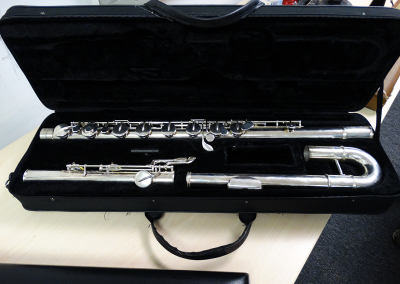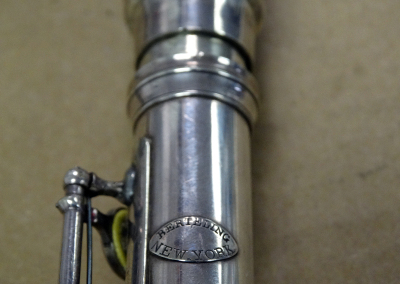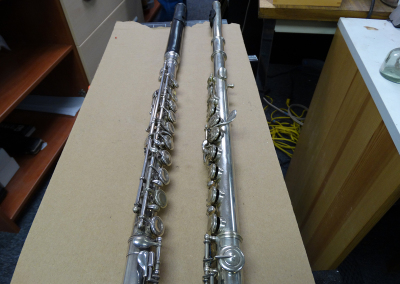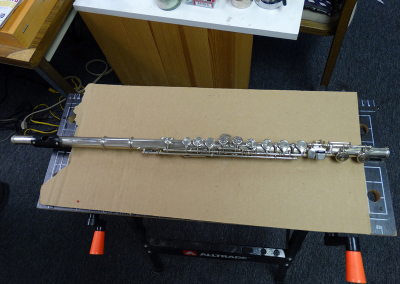THE MODERN METAL FLUTE AND ITS QUALITIES
Today’s standard soprano metal flute was developed originally by Theodore Boehm in the mid nineteenth century. Boehm decided to design a flute, not based on convention, but on modern experimental techniques. And so he fabricated many cylindrical tubes of varying lengths to find the exact position necessary to locate every tone hole in order to sound each note of the chromatic scale accurately. In this process he found that the cylindrical (not the conical tube of the earlier flutes) tube was the best form for the body of the flute and that a slightly parabolic tube was the best for the head joint. The tone-hole positions and size, in order to maintain the pitch and accuracy, were such that each had to be closed by a key containing an air-tight pad. Boehm designed a series of mechanical levers, axles and springs to facilitate the opening and closing of the keys by the flute player. His early flutes were closed=hole keys with an open G# and a reverse thumb mechanism. As his flute gained in popularity several changes were made to accommodate the needs of professional flute players. The first change was to the open G#; by making the G and G# keys one unit and boring a duplicate G# tone hole on the thumb side of the flute to be opened and closed by a key attached to a lever located between the G/G# unit the flute was now a closed G# instrument. The Boehm thumb B/Bb mechanism was replaced by an assembly designed by an Italian flautist, Briccialdi and is now the standard used by all flute makers. The French decided that the fingered keys in order to make the flute more flexible should be “perforated” and so developed an open holed design for the A, G, F, E and D keys. Boehm’s original flute played down to C, but the modern flute now has the option of a foot joint with a low B key. Today’s flute is a truly remarkable instrument not reserved for the few masters but open to all who have the time and interest to play it. It is rugged, easily carried, relatively inexpensive and a beautiful instrument to possess.
Answers to common questions:
Does my flute need regular maintenance?
Yes, at least once a year your flute should be cleaned, oiled and checked for leaks.
Can dents be taken out of my flute’s body?
In most cases yes. On non plated instruments dent removal is usually 100% successful with no visual evidence of the original imperfection. On plated instruments even though the dent is removed there is often a scar in the plating where the original dent was.
Can I raise or lower the pitch of my flute by moving the cork stopper?
No, Boehm’s original design mandated that the cork-face-plate be 17.5 mm from the center of the embouchure hole to guarantee the intonation of each note.
How can I change the pitch of my flute
The pitch of the flute can only be lowered and only slightly by pulling the head-joint out, but no more than .25”( ¼”)
What is the use of the cork stopper?
The cork stopper seals the upper portion (above the embouchure hole) of the head joint and should be checked regularly for its’ proper position and for possible leakage. I change the cork in my flutes on a yearly basis.
How long do the pads last on my flute?
Depending on several factors that’s a difficult question to answer but here are some of the possibilities.
1. Double or single skinned pads….double are better and will last longer
2. Exposure to changing conditions such as heat, moisture, too much finger pressure on the keys, irregular tone hole edges, insect larvae, and poor flute care are all the enemies of flute pads.
3. Poorly installed pads by an unqualified flute technician.
4. Fine pads properly installed and maintained can last 10 years or more.
Should I polish and clean my flute regularly?
Never use any polish on an assembled flute because the abrasive in the polish will find its way into the mechanism and clog up the works. Clean your flute with a dry soft cloth both inside and out using the swab stick provided by the manufacturer.
How do I know that the cork is in the proper position?
The swab stick is marked at the blunt end with a line that is 17mm from that end. Slide the stick up into the head joint till it stops at the cork stopper….the line should appear at the middle of the embouchure hole. The crown at the top of the head joint is threaded and can be loosened or tightened to move the stopper mechanism. If the line is above the middle of the embouchure hole then you should loosen the crown (counterclockwise) and push on it until the stopper moves into the proper position (re-snug up the crown at that point). If the line is below the middle of the embouchure hole then by tightening the crown (clockwise) you will move the cork up into position.
Please feel free to post any other concerns you may have about your flute and its maintenance and I will answer you.




